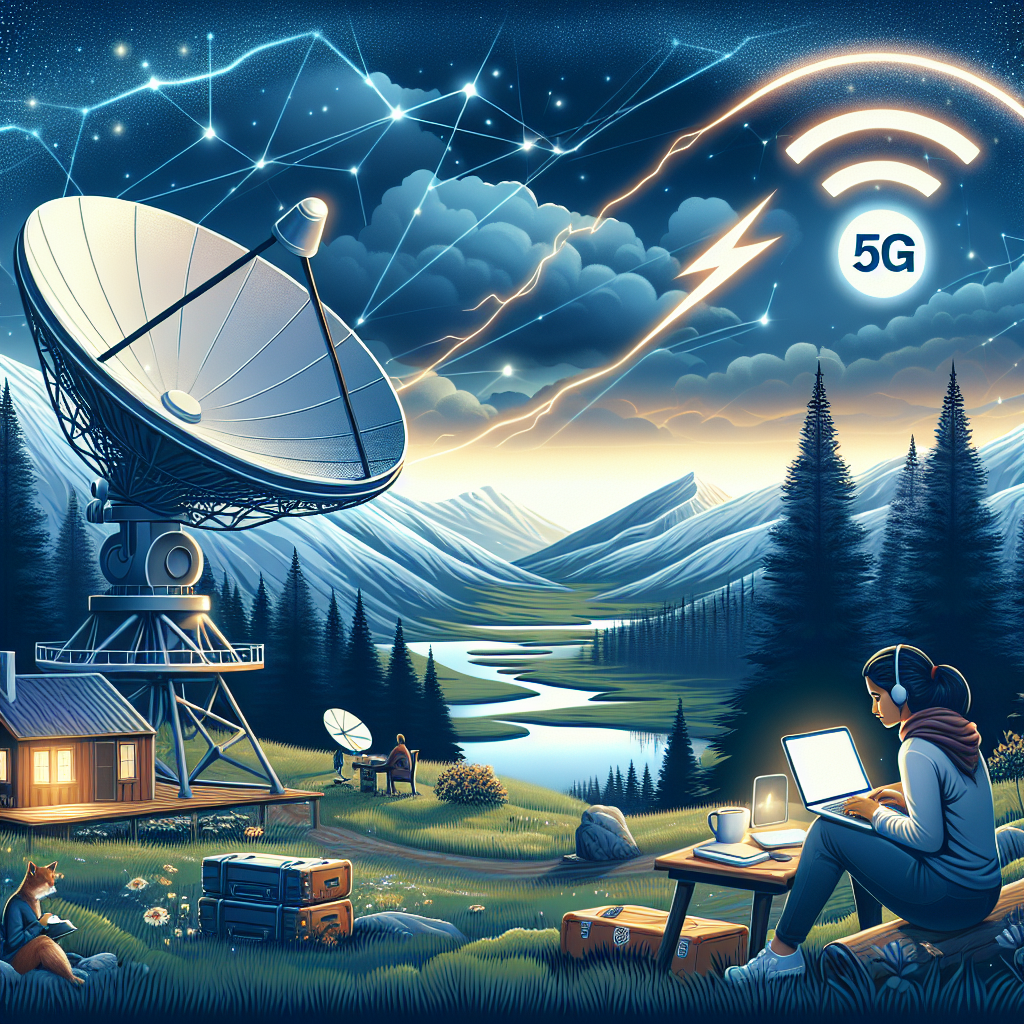In today’s digital age, access to high-speed internet is more essential than ever, especially for those living in remote locations. The lack of reliable internet can hinder productivity, limit educational opportunities, and disconnect individuals from the rest of the world. However, advancements in technology have paved the way for innovative solutions to bring high-speed internet to even the most remote areas. From satellite internet to wireless broadband, there are now options available to bridge the digital divide and connect remote locations to the vast resources of the internet. Explore the possibilities of high-speed internet for remote locations and unlock a world of limitless opportunities.
Understanding the Challenges of Remote Locations

Remote locations present unique challenges when it comes to accessing high-speed internet due to various factors that hinder connectivity. These challenges include:
- Lack of infrastructure: Remote locations often lack the necessary infrastructure to support high-speed internet connections. This can be attributed to the high costs associated with extending network infrastructure to these areas, making it financially unfeasible for service providers to invest in such projects.
- Limited connectivity options: In remote locations, the options for internet connectivity are limited, with traditional broadband services being unavailable or unreliable. This limitation stems from the lack of competition among service providers in these areas, resulting in a lack of incentive to improve or expand existing networks.
- Geographic barriers: The geography of remote locations, such as mountainous terrain, dense forests, or vast distances, can pose significant challenges to establishing reliable internet connections. These physical barriers can interfere with signal transmission and infrastructure deployment, further complicating efforts to bring high-speed internet to these areas.
Exploring High-Speed Internet Solutions
Satellite Internet
Satellite internet is a high-speed internet solution that offers unique advantages and disadvantages, particularly beneficial for individuals residing in remote locations.
Advantages:
– Wide coverage: One of the primary advantages of satellite internet is its extensive coverage span. It reaches areas where traditional cable or fiber-optic internet services may not be accessible.
– Accessible in remote areas: Satellite internet is especially valuable for individuals living in remote or rural locations where other forms of high-speed internet are unavailable.
Disadvantages:
– Latency issues: A notable drawback of satellite internet is the latency it often experiences. The time delay in signal transmission can impact real-time activities like online gaming or video conferencing.
– Weather interference: Satellite internet signals can be influenced by inclement weather conditions such as heavy rain or snow, potentially disrupting the connection reliability.
Fixed Wireless Internet
Exploring High-Speed Internet Solutions
Fixed wireless internet is a promising solution for providing high-speed internet access to remote locations. It offers several advantages that make it a viable option for bridging the digital divide in underserved areas.
- Advantages
- Faster speeds: Fixed wireless internet can deliver fast download and upload speeds, comparable to traditional wired connections, making it suitable for bandwidth-intensive activities like video streaming and online gaming.
- Reliability: Unlike satellite internet, fixed wireless connections are less susceptible to signal interference from weather conditions, ensuring a more reliable internet connection for users in remote locations.
- Disadvantages
- Line of sight requirements: One of the main limitations of fixed wireless internet is the need for a clear line of sight between the transmitter and the receiver. Obstructions like trees, buildings, or terrain can hinder the signal quality and impact the reliability of the connection.
- Limited availability: Fixed wireless internet infrastructure may not be as widespread as other types of internet technologies, limiting access for residents in extremely remote or isolated areas. This lack of coverage can pose challenges for expanding high-speed internet access to all remote locations.
Fiber Optic Internet
Advantages
– Lightning-fast speeds: Fiber optic internet offers unparalleled speed, capable of reaching up to 1 gigabit per second. This allows for seamless streaming, fast downloads, and smooth online gaming experiences.
– Stable connection: Unlike traditional copper wire connections, fiber internet is not susceptible to electromagnetic interference or inclement weather conditions. This results in a more reliable and consistent connection.
Disadvantages
– Limited reach: One of the primary drawbacks of fiber optic internet is its limited availability in remote locations. The infrastructure required to deploy fiber optic cables can be costly and challenging to implement in sparsely populated areas.
– Cost considerations: The installation and maintenance of fiber optic internet infrastructure can be expensive, making it less feasible for areas with lower population density or limited financial resources.

Overcoming Connectivity Challenges
In remote locations, accessing high-speed internet has historically been a challenge due to the lack of infrastructure and geographical barriers. However, various strategies have been implemented to overcome these connectivity challenges, including government initiatives, private sector investments, and technological advancements.
Government Initiatives
- Funding for Infrastructure: Governments have allocated funds to improve internet infrastructure in remote areas, aiming to bridge the digital divide. These initiatives involve laying down fiber-optic cables, setting up satellite connections, or utilizing wireless technology to extend coverage to underserved regions.
- Regulatory Support: Governments have also introduced policies and regulations to incentivize internet service providers to expand their services to remote locations. This may include subsidies, tax incentives, or partnerships with telecom companies to ensure broader coverage and affordable access for residents in these areas.
Private Sector Investments
- Telecom Expansion: Private sector investments play a crucial role in extending high-speed internet to remote locations. Telecom companies are increasingly exploring opportunities to expand their networks and offer services in areas that were previously deemed unprofitable. This expansion is often driven by the potential for growth and the increasing demand for connectivity worldwide.
- Partnerships with Local Communities: In some cases, private sector entities collaborate with local communities or organizations to establish internet connectivity in remote areas. These partnerships may involve sharing resources, expertise, or leveraging existing infrastructure to bring high-speed internet to underserved populations.
Technological Advancements
- Satellite Technology: Technological advancements, such as satellite internet, have revolutionized connectivity options for remote locations. Satellites can now provide high-speed internet access to areas where traditional infrastructure deployment is challenging or cost-prohibitive. This technology offers a reliable connection for remote communities, enabling them to participate in the digital economy.
- Wireless Solutions: Wireless technologies, like 4G and 5G networks, have also improved access to high-speed internet in remote locations. These solutions offer flexible connectivity options that can be deployed rapidly, making them suitable for areas where traditional wired connections are not feasible. By leveraging wireless networks, remote communities can enjoy faster internet speeds and better connectivity for various applications.

In conclusion, overcoming connectivity challenges in remote locations requires a multi-faceted approach that combines government initiatives, private sector investments, and technological advancements. By addressing infrastructure gaps, regulatory barriers, and leveraging innovative solutions, high-speed internet access can be extended to even the most secluded areas, fostering digital inclusion and economic development.
The Future of High-Speed Internet in Remote Areas
The future of high-speed internet in remote areas is rapidly evolving, with technological advancements paving the way for improved connectivity even in the most isolated regions. Several key developments are shaping this future:
5G Technology
- 5G technology holds great promise for bringing high-speed internet to remote locations. With its faster speeds, lower latency, and increased capacity, 5G can overcome many of the traditional barriers to connectivity in rural and remote areas. By leveraging small cells and advanced antenna technologies, 5G networks can extend coverage to previously underserved areas, providing residents with access to high-speed internet for various applications.
- Moreover, the deployment of 5G infrastructure in remote locations can support not only individual users but also businesses, educational institutions, and healthcare facilities. This technology opens up opportunities for remote work, telemedicine, distance learning, and other online services that rely on reliable and fast internet connections.
Low Earth Orbit (LEO) Satellites
- Another promising development in the realm of high-speed internet for remote locations is the use of Low Earth Orbit (LEO) satellites. Companies like SpaceX, OneWeb, and Amazon are investing in satellite constellations to provide global broadband coverage, including in remote and underserved areas. These LEO satellites operate closer to the Earth’s surface, reducing latency and enabling faster data transmission compared to traditional geostationary satellites.
- By beaming internet signals from space, LEO satellite networks can reach remote locations where terrestrial infrastructure is limited or nonexistent. This approach is particularly beneficial for connecting remote communities, islands, and rugged terrains that are challenging to serve with traditional fixed-line networks. As these satellite constellations continue to expand and improve, more people in remote areas will gain access to high-speed internet for communication, entertainment, and economic opportunities.
Community-Driven Solutions
- In addition to technological advancements, community-driven solutions play a crucial role in expanding high-speed internet access in remote areas. Local initiatives, cooperatives, and public-private partnerships can help bridge the digital divide by deploying innovative connectivity solutions tailored to the specific needs of remote communities. By involving residents in the planning and implementation process, these initiatives can ensure that high-speed internet infrastructure meets the unique challenges and requirements of remote locations.
- Community networks, mesh networks, and shared infrastructure models are examples of community-driven solutions that empower residents to take control of their internet connectivity. By pooling resources, sharing infrastructure, and collaborating with local stakeholders, communities can establish sustainable and affordable high-speed internet services in even the most remote and underserved areas. This bottom-up approach not only fosters digital inclusion but also fosters community resilience and economic development in remote locations.
FAQs: High-Speed Internet for Remote Locations
What options are available for high-speed internet in remote locations?
There are several options available for high-speed internet in remote locations. One option is satellite internet, which uses satellites in space to provide internet access. Another option is fixed wireless internet, which uses radio signals to provide internet access to remote areas. Additionally, some remote locations may have access to fiber-optic internet, which provides high-speed internet through cables made of glass or plastic fibers.
How can I determine if high-speed internet is available in my remote location?
To determine if high-speed internet is available in your remote location, you can contact local internet service providers or check their websites for coverage maps. You can also use online tools and resources to search for internet options in your area. Additionally, you can ask neighbors or other residents in the area about their internet services and availability.
What factors should I consider when choosing high-speed internet for a remote location?
When choosing high-speed internet for a remote location, there are several factors to consider. These factors include the type of internet service available, the speed and reliability of the connection, the cost of the service, and any data caps or restrictions that may apply. It is also important to consider the level of customer support and technical assistance provided by the internet service provider.
Are there any challenges or limitations when using high-speed internet in remote locations?
There can be challenges and limitations when using high-speed internet in remote locations. Some common challenges include limited availability of high-speed internet options, slower connection speeds due to distance from service providers, and potential service disruptions due to weather conditions or other factors. Additionally, some remote locations may have higher costs for internet services or may be more prone to network congestion during peak usage times.